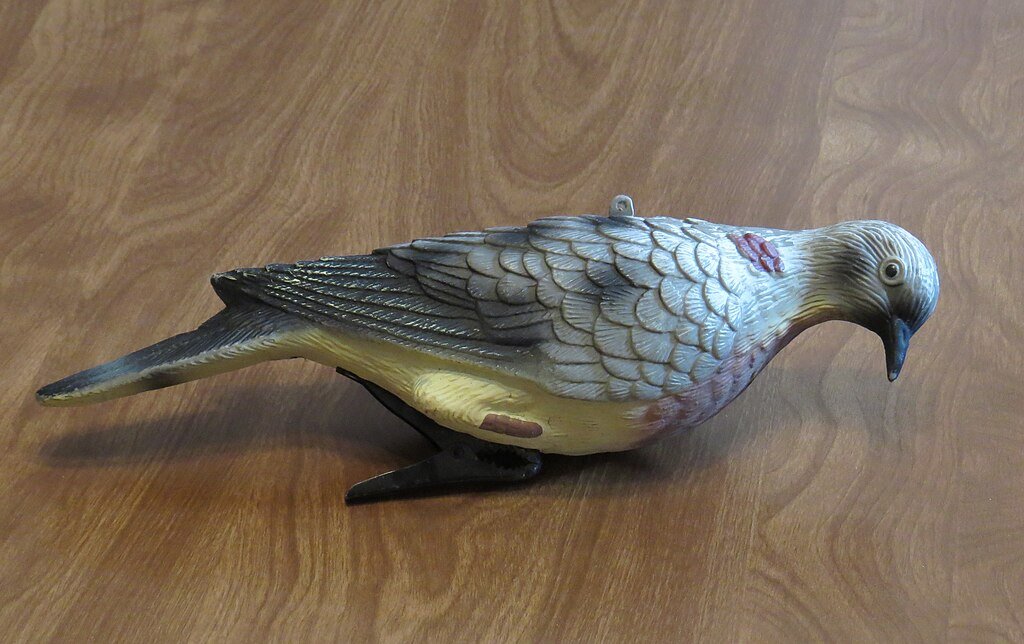1 July 2024
In American underworld slang, a stool pigeon is a police informer. The stool is puzzling to most. It is a variant on an older word, stale, meaning a decoy or lure.
That word comes from the Old English stæl, meaning place (also the source of our present-day word stall). The Old English root was reinforced by the Anglo-Norman estal, also meaning both place and decoy, and ultimately coming from the same Germanic root as the Old English word. It’s unrelated to the other main use of stool, which is from the Old English stol, meaning seat or throne.
We see this Old English root in the compound stælhran, meaning a decoy reindeer. From the Old English translation of Orosius’s Historiarum adversum paganos (History Against the Pagans):
Þa deor hi hatað “hranas”; þara wæron syx stælhranas; ða beoð swyðe dyre mid Finnum, for ðæm hy foð þa wildan hranas mid.
(They call the beasts “reindeer”; there were six stool-reindeer; they are very dear to the Finns, for they capture the wild reindeer with them.)
And we see it used in relation to hunting birds in the c. 1440 English-Latin dictionary Promptorium Parvalorum. But here the word staal is used to refer to a hunting blind rather than a lure:
Staal of fowlynge or off byrdyes takynge: stacionaria
We see the lure sense about a century later, in Richard Huloet’s 1552 dictionary, Abcedarium Anglico-Latinum:
Stale that fowlers vse, incitabulum, mentita auis.
(Stool that fowlers use, [an incentive, a pretend bird].
It is applied more figuratively to people a bit earlier in John Skelton’s (d. 1529) poem The Tunnyng of Elynour Rummyng. The poem is about a less-than-honest alewife, and this particular passage is about how her ale lures the villagers:
Some for very nede
Layde downe a skeyne of threde,
And some brought from the barne
Both benes and pease;
Small chaffer doth ease
Sometyme, now and than:
Another there was that ran
With a good brasse pan;
Her colour was full wan;
She ran in all the hast
Vnbrased and vnlast;
Tawny, swart, and sallowe,
Lyke a cake of tallowe;
I swere by all hallow,
It was a stale to take
The deuyll in a brake.(Some for great need
Laid down a skein of thread.
And some brought from the barn
Both beans and peas;
A little bargaining does the price ease
Sometime, now and then:
Another there was who ran
With a good brass pan;
Her color was very wan:
She ran in all haste,
Loose and unlaced;
Tawny, dark, and sallow,
Like a cake of tallow;
I swear by all that is hallowed,
It was a stool to take
The devil in a snare.)
But the compound stool pigeon would have to wait until turn-of-the-nineteenth-century America, where it was first applied to a dupe who would then be used to lure others into some kind of “trap.” Here is an early use in New York City’s American Citizen of 19 April 1800 in a political context:
The federalists laughed in their sleeves at this event—they held a CAUCUS and resolved (these are there [sic] own words) to make a decoy duck or stool pigeon of some pliable cartman for the purpose of getting the votes of his fellows in business.
And by the 1830s we see the sense of a police informer, one who entraps their fellows in crime. From the Vermont Watchman of 25 January 1831:
One hundred dollars are offered as reward for the apprehension of the above villain, and we hope the city authorities will at once take the matter in hand, and offer an additional sum of large amount, so that the officers of the police and their “stool pigeons” may be excited to go upon the track of the offenders.
Sources:
Anglo-Norman Dictionary, 2007, s.v. estal, n.1, estal, n.3.
“Another Attempt at Abduction.” Vermont Watchman and State Gazette (Montpelier), 25 January 1831, 4/1. Readex: America’s Historical Newspapers.
Green’s Dictionary of Slang, n.d., s.v. stool-pigeon, n.1.
Huloet, Richard. Abcedarium Anglico-Latinum. London: William Riddel, 1552. HathiTrust Digital Archive.
Mayhew, A. L., ed. Promptorium Parvalorum (c. 1440). Early English Text Society. London: Kegan Paul, Trench, Trübner, 1908, col. 432, 704–05. HathiTrust Digital Archive.
Middle English Dictionary, 2019, s.v. stal(e, n.4.
Oxford English Dictionary, second edition, 1989, s.v. stool-pigeon, n., stale, n.3.
Skelton, John. “The Tunnyng of Elynour Rummyng.” The Poetical Works of John Skelton, vol. 1 of 3. Boston: Little, Brown, 1862, 109–131 at 120–21. HathiTrust Digital Archive.
Sweet, Henry, ed.. King Alfred’s Orosius, part 1. Early English Text Society, o.s. 79. London: Oxford UP, 1883, 1.1, 18. HathiTrust Digital Archive.
“To the Cartmen of the City.” American Citizen and General Advertiser (New York City), 29 April 1800, 3/4. Readex: America’s Historical Newspapers.
Photo credit: Andy Reago and Chrissy McClarren, 2016. Wikimedia Commons. Used under a Creative Commons Attribution 2.0 Generic license.

